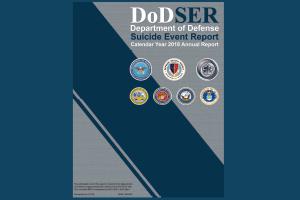Skip subpage navigation
By Jennifer Tucker, Ph.D.
April 27, 2020
 PHCoE graphic
PHCoE graphic
The 2018 Department of Defense Suicide Event Report (DODSER) Annual Report was published today. For those who are not familiar with the DODSER, the report details total numbers of reported suicide deaths and attempts among U.S. service members during the calendar year and describes suicide mortality rates for the military components and services. In addition, the report presents data on variables ranging from rank and marital status to method of injury and communication of suicide intent for cases of suicide attempt and death.
2018 Military Suicide Mortality Rates
- For the active component, the rate was 24.8 suicide deaths per 100,000 service members. The rates for the active component demonstrated statistically significant increases from 2011 through 2018. Service-specific rates were as follows:
- Air Force: 18.5 suicide deaths per 100,000 airmen
- Army: 29.5 suicide deaths per 100,000 soldiers
- Marine Corps: 31.4 suicide deaths per 100,000 Marines
- Navy: 20.7 suicide deaths per 100,000 sailors
- For the reserves, the rate was 22.9 suicide deaths per 100,000 reservists. The rates for the reserves demonstrated statistically significant increases from 2011 through 2018.
- For the National Guard, the rate was 30.6 per 100,000 Guard members. The rates for the National Guard demonstrated increases from 2011 through 2018, but these increases were not statistically significant. National Guard rates can therefore be described as stable from 2011 through 2018.
Comparisons of 2018 military suicide mortality rates with U.S. adult suicide mortality rates
After adjusting for age and sex differences between the military and U.S. general adult populations:
- The 2018 active component rate was similar to the U.S. rate.
- The 2018 reserves rate was similar to the U.S. rate.
- The 2018 National Guard rate was statistically significantly higher than the U.S. rate.
Key results from the DODSER data
- Personal firearm use was the most common method of injury (66.5 percent) reported for suicide deaths among members of the active component.
- Drug and/or alcohol overdose was the most common method of injury (59.0 percent) reported for suicide attempts among members of the active component.
- 39.2 percent of active component service members who died by suicide experienced a failed or failing relationship in the 90 days prior to death.
- 91.7 percent of the failed or failing relationships were romantic in nature.
- 38.5 percent of active component service members with a reported suicide attempt experienced a failed or failing relationship in the 90 days prior to the attempt.
- 88.5 percent of the failed or failing relationships were romantic in nature.
- 32.4 percent of active component service members who died by suicide and 29.5 percent of those with a reported suicide attempt experienced an administrative or legal problem in the 90 days prior to death.
If you're writing about or interpreting findings from the 2018 DODSER Annual Report and have questions or need clarification, contact the PHCoE DODSER team or comment below. The suicide risk section of our website contains additional information about suicide in the military, including evidence-based interventions and relevant DOD policies.
Dr. Tucker is a research psychologist and suicide intervention subject matter expert at the Psychological Health Center of Excellence. She has master's and doctoral degrees in clinical psychology and has worked with service members hospitalized for suicide risk.
You are leaving Health.mil
The appearance of hyperlinks does not constitute endorsement by the Department of Defense of non-U.S. Government sites or the information, products, or services contained therein. Although the Defense Health Agency may or may not use these sites as additional distribution channels for Department of Defense information, it does not exercise editorial control over all of the information that you may find at these locations. Such links are provided consistent with the stated purpose of this website.
You are leaving Health.mil
View the external links disclaimer.
Last Updated: September 14, 2023